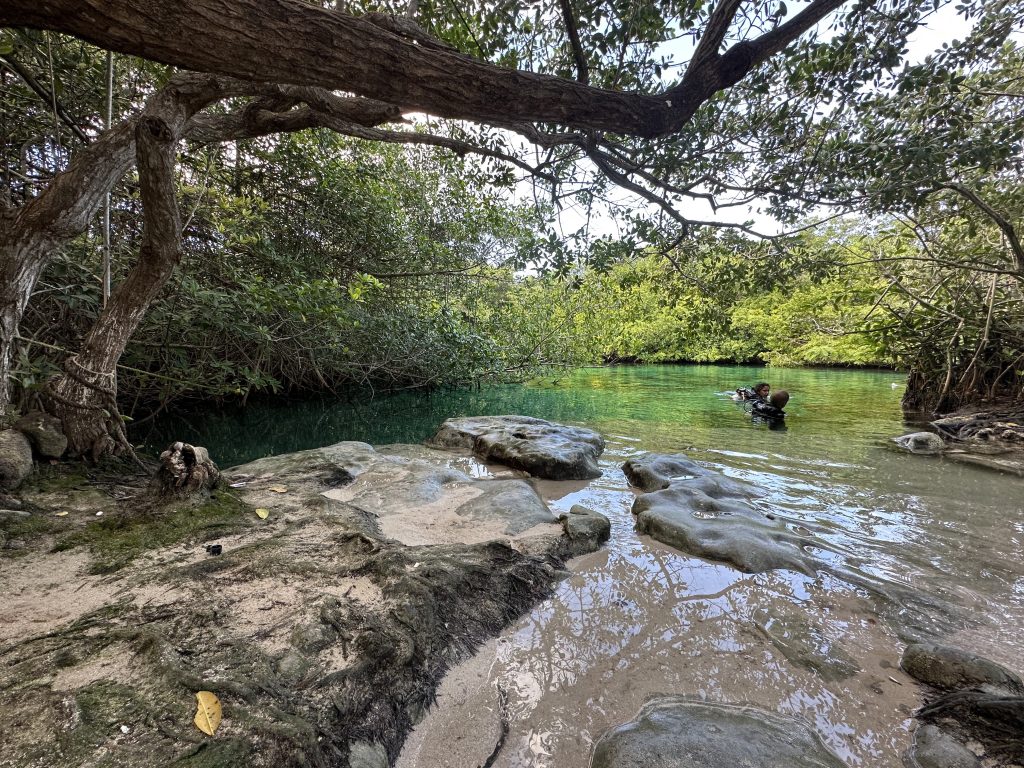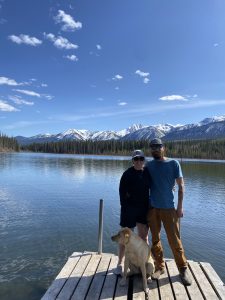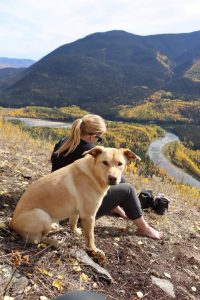My story
Hello friends so I’m going to tell you a story that happened to me just over the Christmas holidays my husband and I went down to Mexico and we decided to go scuba diving and snorkeling In the popular cenotes my husband’s a scuba diver so he did that and I snorkeled in both locations that we went to so the first location we went to was called dose oils which means two eyes because if you were to see it from up above it looks like two eyes which is pretty cool and it’s snorkeling and Diving all throughout these underwater caves which was absolutely incredible and it was so beautiful and I’ve never experienced anything like it and then he went to the second location and it’s sort of reminded me of like Florida mangroves and it was a much smaller place and the smaller operation and before we got there our guide said we’re going to go into the water and we’re going to loop around a little horseshoe Loop and we’re going to see a crocodile or Panchito sitting on a rock it’s always sitting on this rock so we’re going to swim mirror it but far enough away we can just look at it from a distance and so I’m the only one snorkeling and she’s diving our guide is diving with my husband and then two other people who are very experienced divers I think they were just friends of her that wanted to come along so she asks if this is okay and I say of course and because it was quite shallow I was actually going to be snorkeling right above them and was going to be able to see them the whole time and so all sounds good so we get ready we get in the water the scuba divers go down and I am up and so I’m looking down seeing some really big fish in the water and getting to see the beautiful scenery with all the big trees that are kind of Dipping into the water and it was really awesome so I’m looking down I see them and then I look up and stick my head out of the water and I see a crocodile in the water about 30 ft in front of me and I look back down and I see that the guy also notices that the crocodile is in the water and so she looks at my husband and tells him underneath the water however they communicate to stay down and she was going to go up and be with me and so she’s telling him stay down here and then I see her and she’s going to come up and be with me so she calmly comes up out of the water and she tells me in a very calm voice to just go over to the side and hold on to one of the main girls and we’re just going to give the crocodile some space to swim by and so of course I’m a little panicked but I am keeping my calm I’m not splashing around I’m doing what I’m told and I hold on to the tree and sure enough the crocodile is just getting closer and closer and just swimming and then are my guide again just says we’re going to give it space we’re going to let it go bye and she pulls up her little ear thing from her scuba diving tank and she didn’t tell me after what that was for but so the crocodile swims by and is probably about a foot and a half away from me as it swims by and it was a very interesting experience for that to happen and the crocodile swims by and we watch it go by and my guide looks at me and asked me if I’m okay and I say yes I’m okay and she says okay we now have to swim back to the entrance and I knew that I’d have to swim back by the crocodile because it went towards the entrance and so I was a little scared but my guy said she was going to be looking out the whole time and I trusted her so she goes back down we turn around and we start swimming again and I kept looking up and looking down and looking up and looking down and my heart was beating pretty fast at this point and then sure enough we turn a corner and this time when we see the crocodile it is on the floor of the peninsula place we were diving and snorkeling and I could see my guide and she was telling the divers to again stick to the side and she looked up and told me to stick to the side and we all swam buy the crocodile and as soon as we were in front of it it twisted around and swam back the other way from where it came probably to go back to its Rock and then finally we all got back to the entrance where we entered and we were all buzzing it was very exhilarating definitely scary at the time it was happening but in a way that made me feel alive and full of energy we all raved about what a fascinating experience this was even our guide and her friends were ecstatic thanks for listening to my story

How does the text deviate from the conventions of written English?
- Spelling and grammar appeared to be correct throughout the text, the only time spelling deviated was when the recorder misheard what I said (it spelled the word correctly for the word it must have heard).
- Capitalization is not always present or correct, this would also tie into punctuation as there was really only the “beginning” of a sentence with the first spoken words.
- Punctuation is non-existent, it is one long run-on sentence that lacks any structure other than my oral words being put into textual words.
- Dialogue is not indicated.
What is “wrong” in the text? What is “right”?
- As mentioned above the capitalization, punctuation, and dialogue is incorrect. The spelling and grammar appear to be correct.
- I use a few Spanish words, the text incorrectly writes “dose oils” instead of dos oyos, however, it correctly writes panchito and cenotes.
- There are incorrect words such as; the smaller operation, swim mirror it, he went to the second location at it’s sort of reminded, the guy also, but my guy, let it go bye, ear thing, main girls should have alternatively been; a smaller operation, swim near it, we went to the second location and it sort of reminded, the guide also, but my guide, let it go by, air thing, mangroves respectively.
- Dipping, Diving, Loop, Rock, In, and Panchito, are capitalized and shouldn’t be, however, Mexico, Florida, and Christmas are capitalized which is correct. I is correctly capitalized throughout the text/story. It is obviously missing all of the capitalizations that should be present at the beginning of new sentences, but as previously mentioned there is no sentence structure throughout the entire text.
What are the most common “mistakes” in the text and why do you consider them “mistakes”?
- There are some mistakes with the word that is present in the text and this may be due to my pronunciation or annunciation of the words. For example, guy and guide. I would consider these a mistake because most of the wrong words, or words that I did not say aloud but the recorder thought it heard, do not make sense in the story. For example swim mirror it, and main girls.
- Again, the capitalization of words is interesting and it seems as though there is no rhyme or reason for their placement. I wonder if there may have been pauses or emphasis in me speaking those particular words and this is why they are capitalized, although this would not explain why there are no periods.
- Punctuation in this story may have added even the slightest indication that things were exciting, tense, and exhilarating by throwing in a “!” or a suspenseful “…”.
What if you had “scripted” the story? What difference might that have made?
- Although it would have likely looked the same structurally based on the affordances of the speech-to-text program I used, it would have been more polished with word choices for descriptions and adding more detail to paint a better picture for my reader. For example, I would have explained what a cenote is, maybe explained in more detail how big this one was and why the crocodile had to be so close to me as it swam by,
- I used certain words that looking back, I am not sure I knew what I meant at the time, I think I was a little nervous knowing everything I said was being translated into text. For example, Florida mangroves and peninsula place.
- I likely wouldn’t have said and, then, and so as much as I did throughout the story.
- I would have tried to express verbally what I was doing physically, not in the literal sense of “now I am moving my head up and down to indicate in and out of water”, but in a written story sense of setting the stage, using words to convey emotional impact and context of the story.
In what ways does oral storytelling differ from written storytelling?
Oral expression, or storytelling, can exist without writing, however, writing, or written storytelling, is never without orality (Ong, 2002, p.8). Oral storytelling is a dynamic performative art, it relies on body language and a range of human faculties such as gestures, tone, volume, pace, and facial expressions (Callahan, 2006). Things like intonation and emotional content are aspects of oral storytelling that writing can not record, writing records language but not actual speech (Gnanadesikan, 2008, p.9).
As Mark Twain (1897) states:
“The pause is an exceedingly important feature in any kind of story, and a frequently recurring feature, too. It is a dainty thing, and delicate, and also uncertain and treacherous; for it must be exactly the right length — no more and no less — or it fails of its purpose and makes trouble. If the pause is too short the impressive point is passed, and the audience have had time to divine that a surprise is intended — and then you can’t surprise them, of course” (p.9).
Written words are residue, invented to store information (Gnanadesikan, 2008, p.2; Ong, 2002). Writing has organized and enhanced orality into a scientific art through visible markings, making meaningful connections to science and history, creating disjunctions between past and present (Haas, 2013, p.11; Ong, 2002, p.9). Writing is therefore a process of translating time into space (2), written stories are static works of art, like an artifact that is a fixed creation (Gnanadesikan, 2008, p.3, Berve, 2021).
As Haas (2013) discusses:
“For Ong, writing transforms human consciousness by moving language from an aural realm, where it unfolds across time, to a visual realm, where it takes on a primarily spatial quality” (p.9).
As such, written storytelling can be examined, analyzed, and dissected through this visual realm, written words can be pointed to and discussed compared to fleeting spoken words (Gnanadesikan, 2008, p.4). Written storytelling is a more deliberate practice than speaking, carefully crafted to convey messages more precisely, adding to the sense that writing is worth more than speech (Gnanadesikan, 2008, p.5). It is a polished artifact compared to a spontaneous performance of oral storytelling (Berve, 2021). An author is conscious of the potential audiences, they can edit draft after draft to obtain a desired effect (Callahan, 2006).
Last thoughts
What would society look like without writing?
As we have read, writing is fundamentally rooted in control:
“As human societies became more complex, those attempting to control them found that their memories were overtaxed. What they needed was an external storage device. What they came up with is writing” (Gnanadesikan, 2008, p.3).
That the societies that have been created, based on this control, have happened in the advent of state administration and bureaucracy, in trade and commerce, and in religion. I wonder if society has just been conditioned to believe that writing is a necessity. That evolution has made our brains less capable to store information because as time went on we required our brains to store less and less information. Just think about the advent of cellphones, storing numbers I used to have memorized, having information at my fingertips so my brain inadvertently knows it does not have to retain information, and plugging every destination into google maps.
In a world with no writing, we may pay more attention to knowledge keepers in philosophy and science, and celebrate Indigenous ways of knowing over western practices of data and graphs. An interesting sentiment from Ong (2002);
“Nevertheless, without writing, human consciousness cannot achieve its fuller potentials, cannot produce other beautiful and powerful creations” (p.14).
Indigenous peoples have spent thousands of years passing down stories, traditions, agricultural practices, values, beliefs, and language through oral storytelling. The First Peoples Principles of Learning were written recently, but have been practiced for centuries. Indigenous peoples have been stewards of the land for time immemorial. If someone would like to argue that the fuller potential is overpopulation, climate change, deforestation, and mass extinction at alarming rates then I welcome the discussion. These creations are powerful, yes, but not so much beautiful.
References
Berve, C. (March 28, 2021). What Are the Differences between Riveting Oral and Written Storytelling. Ignited Ink Writing. https://www.ignitedinkwriting.com/
Callahan, S. (August 21, 2006). Storytelling versus story-writing. Anecdote. https://www.anecdote.com/
Gnanadesikan, A.E. (2011). The first IT revolution. In The writing revolution: Cuneiform to the Internet (pp. 1-12). John Wiley & Sons.
Haas, C. (2013). The technology question. In Writing technology: Studies on the materiality of literacy (pp. 3-23). Routledge.
Ong, W.J. (2002). Chapter 1: The orality of language. In Orality and literacy: The technologizing of the word (pp. 5-16). Routledge. (Original work published 1982).
Twain, M., Ingold, E., Clemens, O., Ernest Ingold Collection of Mark Twain (University of Illinois at Urbana-Champaign Library)., American Wit and Humor Collection (University of Illinois at Urbana-Champaign Library). Franklin J. Meine Collection., Harper & Brothers. (1897). How to tell a story, and other essays. New York: Harper & Brothers Publishers.



